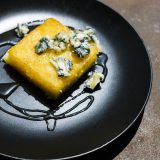The polenta I know— a cornmeal porridge too often too rich and dense with a heft of cheese, yet somehow simultaneously tasteless—is a tedium of attention and constant whisking over heat, low and slow. It’s hard to imagine how Maria Teresa Marino has time for this.
Her family and its centuries-old grain mill buzz as she hoists a giant pot of polenta—golden, steaming and smooth—from the stove to a kitchen table scattered with bread and wine. Her husband, sons and their wives are a flurry, talking business, babies and the bubbles of their local asti spumante, mostly all at once.
But as the polenta is ladled into bowls—topped with a thin red sauce alluringly named bagna d’inferno, or hell’s bath—the swirl ceases and spoons are lifted. In that rare quiet, it becomes obvious: This is most definitely not the polenta I know.
It is light and almost airy, with a sweet aroma, like freshly husked corn. The taste is creamy, not cloying or heavy. Most surprisingly, the flavor of the corn is bright, clean, singular and strong. This was the polenta I’d come to Italy to learn. Done well, it is a comforting foil for rich meats and sauces. Done badly—and it so often is—polenta is larded with cheese and fat that mask the simplicity of the corn.
Marino shrugs me off. The polenta cooks itself, she explains. Surely a humble exaggeration, but an explanation would need to wait. The family first wanted me to visit their mill across the courtyard to see the ancient process that made this meal possible.
Polenta has been a staple of northern Italian cuisine for several hundred years. Most recipes are intimidatingly overwrought, demanding precise temperatures of water and constant whisking for 30, 40, even 60 minutes. Then there is the copious cheese and butter, which can turn an already-heavy dish leaden.
The family’s Mulino Marino (Marinos’ Mill) is hidden in Cossano Belbo, a hilltop village of 1,000 people about two hours south of Milan. It is reached by terrifying single-lane gravel switchbacks centuries, the mill has been using 1.2-ton stone disks to grind a wide variety of grains into flours. The Marinos have been its custodians since the 1950s.
When I first arrive at the mill—a yellow villa with soaring arched ceilings once part of the village castle, most of which was destroyed in a battle around the year 1200—I first notice the air, sweet and dry with the smell of corn. Inside, 25-kilogram sacks of flour are stacked in towers. Ten massive mills are designated for a specific grain—spelt, rye, wheat, barley and on. On this day, the corn hoppers are full.
Each mill uses two stones— 6-foot rounds cut from the rock of months must be freshly etched by hand using a pick and hammer, the pattern different for each grain. Though most commercial grain mills use steel blades, stones move more slowly and generate less heat, which can damage—and therefore diminish—both nutrients and flavor compounds. As the mills spin, grain spills into a hole cut into the center of the top stone and is crushed as the stones rotate, pushing the flour to the edge, where it pours out in a stream.
Though some of the equipment has been modernized—the stones now churn in stainless-steel cylinders—the mechanics of the process are mostly unchanged. The mills reserved for corn are still housed in massive wooden barrel-like containers, the gears and levers also wood. One worker dumps a sack of kernels into a hopper; a second monitors the cornmeal exiting below, adjusting the speed and fineness of the grind with an iron wheel. The cornmeal emerges warm, gritty and smelling strongly of oil and fresh sweetness.
In the midst of it, elderly women from the village totter in, and the Marino brothers stop grinding to sell them cornmeal. A cool rain is forecast—polenta weather. Compared to commercial operations, these mills work slowly, grinding just 250 kilograms of flour an hour. But this allows for more control over the quality, and to grind faster would risk burning the grains.

The medieval simplicity of the process—not to mention the impossible freshness of the product—seduced and worried me. Maria Teresa’s polenta was so much better and so different than any I’d had. If the difference was due to the product rather than the cooking method, our chances of replicating it at Milk Street were doomed.
Back in Maria Teresa’s modern but simple kitchen—with windows that look down onto the stone courtyard outside the mill—I began to understand what sets her polenta apart. It isn’t what she puts into the cornmeal or what she does to it. Rather, it is what she leaves out and what she doesn’t do to it.
To start, there is no cheese. Nor butter. And, best yet, there is little stirring. All of it heresy to conventional polenta wisdom. Yet evidence that her approach works—brilliantly so, in fact—sits deliciously on my plate. Though only for moments: I eat it that quickly.
Maria Teresa walks me through than boiling salted water (far more than expected), then sprinkling in coarse cornmeal, returning it to a boil and stirring vigorously for 10 minutes. Cover, lower the heat and walk away. After an hour (the Marinos like to let it go longer, but admit it’s usually done after about an hour), Maria Teresa uncovers the pot and vigorously stirs the polenta again for a few minutes. It’s done.
No wonder the flavor of the corn is so pronounced, so naturally sweet, so simple. Sure, the cornmeal starts out more flavorful. But it isn’t hidden by cheese and butter. Though it needs nothing—I could eat it plain by the bowl—the bagna d’inferno is the polenta’s perfect savory counterpunch.
The science bears out the wisdom of Maria Teresa’s method. She used coarse cornmeal, which is less likely than fine to turn gummy when cooked and has more flavor because it contains some of the germ and bran of the kernels.
Her vigorous initial stirring—always with a whisk, not a spoon—was also key; it quickly releases a significant amount of starch from the corn, so much so that continued stirring during cooking is unnecessary. That starch is rapidly gelatinized by the hot water, producing a thick, smooth polenta in which than sinking to the bottom, where they are more likely to burn or stick—remain suspended. And that is what allows her to walk away from the pot during most of the low-heat cooking.
Despite—or perhaps because of—the simplicity of Maria Teresa’s recipe, at Milk Street we struggled to replicate her results with the same ease. Stovetops are notoriously inexact; low on one could be medium-low on another. This forced us to babysit our polenta more than we wanted to ensure it didn’t stick and burn.
She had also used a nonstick stockpot and a flame tamer, a thin metal disk that sits between the pot and the burner to moderate the heat. Because neither of those is common in American kitchens, we knew we needed a workaround. Since the gentlest, most even heat is in the oven, we decided to try a hybrid approach.
We started our polenta as Maria Teresa did—using stone-ground cornmeal on the stovetop and with vigorous initial whisking. Though she sprinkles her cornmeal slowly into boiling water—in an effort to prevent clumping—we found we could reduce the risk of clumping even more by combining the cornmeal with cold water, then bringing the entire pot to a simmer.
We also followed her lead on the amount of water. Usually recipes call for as little as 6 cups of water for 2 cups of cornmeal. We found that nearly doubling that ratio gave us the smooth, creamy results I’d tasted in Italy.
After the initial whisking, we transferred the pot to a 375°F oven, where it cooked with little attention—we whisked it just once after an hour of cooking, followed by about 15 more minutes of cooking. A final quick whisk on the stovetop was all that was needed to produce the same light, airy corn-flavored polenta I’d enjoyed at Maria Teresa’s table.






